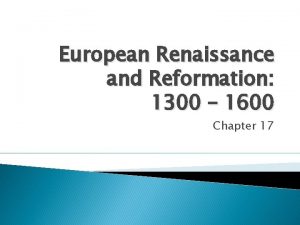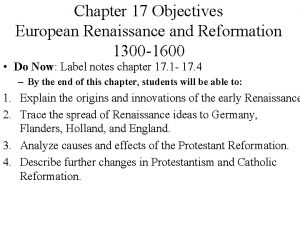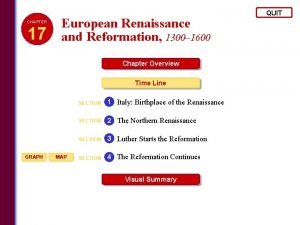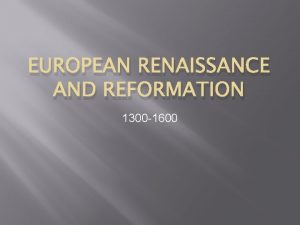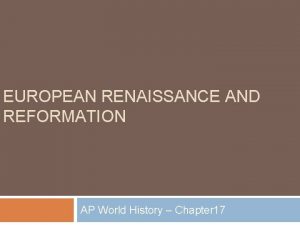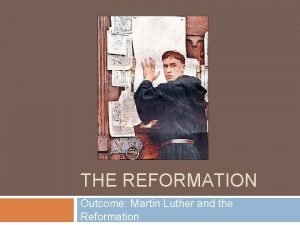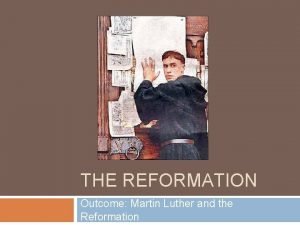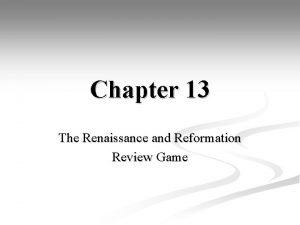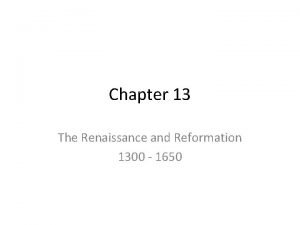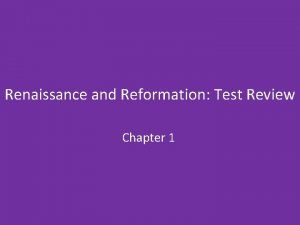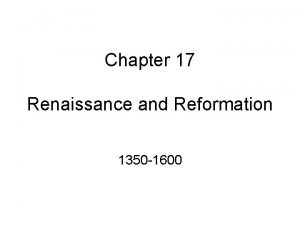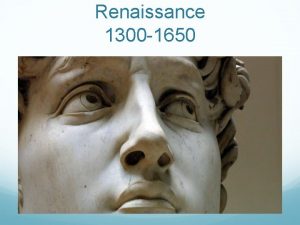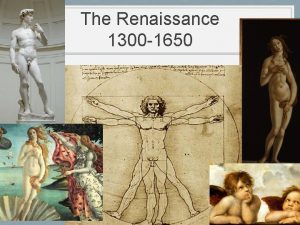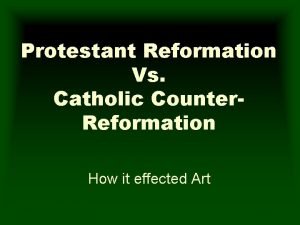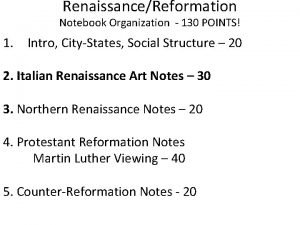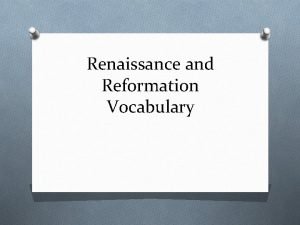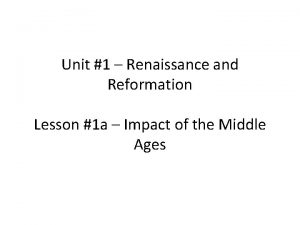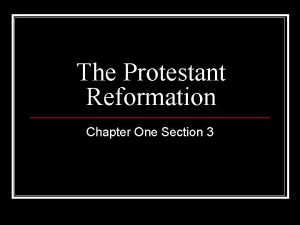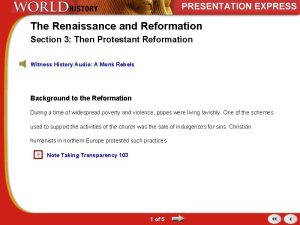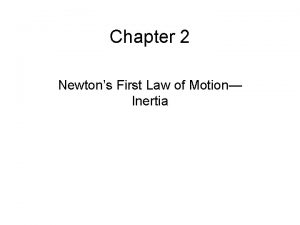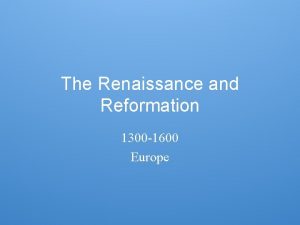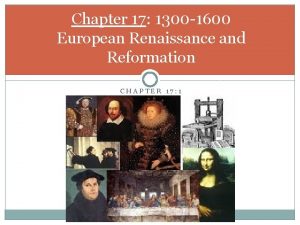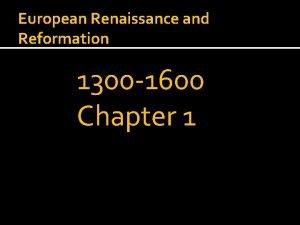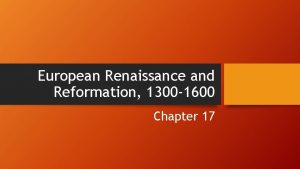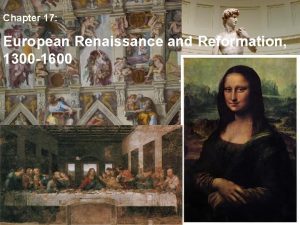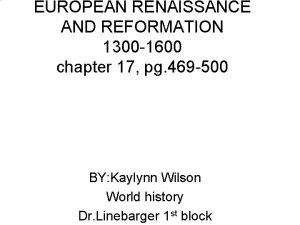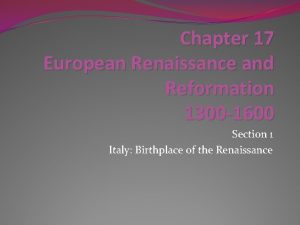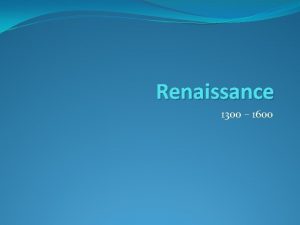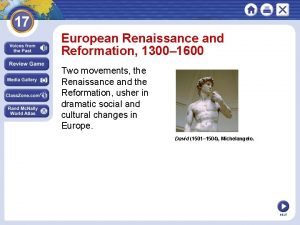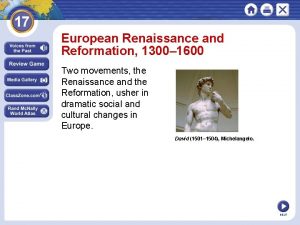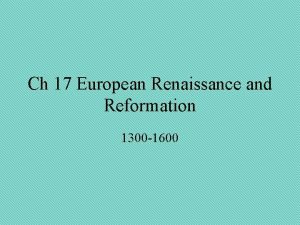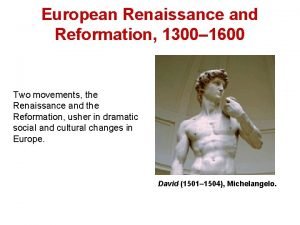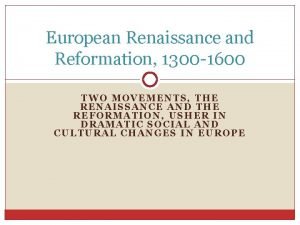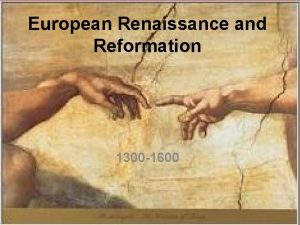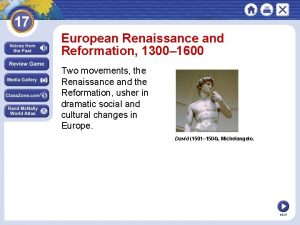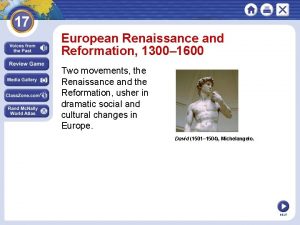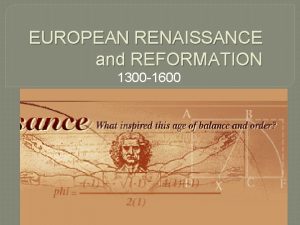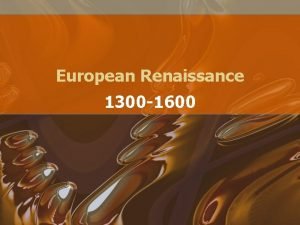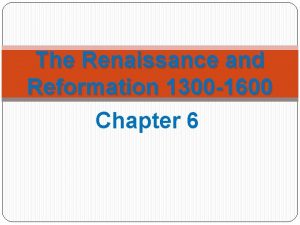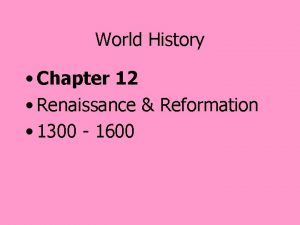Chapter One European Renaissance and Reformation 1300 1600
























- Slides: 24

Chapter One European Renaissance and Reformation, 1300 -1600

1. Italy: Birthplace of the Renaissance • The years 1300 to 1600 saw a rebirth of learning and culture in Europe. • Called the Renaissance, it spread north from Italy. • It began there for three reasons: 1. Italy had several important cities, whereas most of northern Europe was still rural. 2. These cities included a class of merchants and bankers who were becoming wealthy and powerful. 3. Italian artists and scholars were inspired by the ruined buildings and other reminders of classical Rome.

• That new interest in the classical past led to an important value in Renaissance culture – humanism. • This was a deep interest in what people have already achieved as well as what they could achieve in the future. • Scholars did not try to connect classical writings to Christian teaching but tried to understand them on their own terms. • Renaissance thinkers stressed the things of the world. • In the Middle Ages, the emphasis had been mostly on spiritual values.

• One way that powerful or wealthy people showed an interest in worldly things was by paying artists, writers, and musicians to create beautiful works of art. • During the Renaissance, men tried to show that they could master many fields of study or work. • Someone who succeeded in many fields was admired greatly. • The artist Leonardo da Vinci was an example of this idea. He was a painter, a scientists and an inventor.

• Men were expected to be charming, witty, well-educated, well-mannered, athletic, and self-controlled. • Women were expected not to create art but to inspire artists.

• Renaissance artists sometimes used new methods. • Sculptors made figures more realistic than those from the Middle Ages. • Painters used perspective to create the illusion that their paintings were three-dimensional. • The subject of artwork changed as well. • Art in the Middle Ages was mostly religious, but Renaissance artists reproduced other views of life. • Michelangelo showed great skill as an architect, a sculptor and a painter.

• Renaissance writers reached high achievements as well. • Several wrote in their native languages, whereas most writing in the Middle Ages had been in Latin. • Writers also changed their subject matter. • They wrote to express their own thoughts and feelings or to portray in detail an individual.

• Dante and others wrote poetry, letters, and stories that were self-expressive and more realistic. • Niccolo Machiavelli took a new approach to understanding government. • He focused on telling rulers how to expand their power, even if that meant taking steps that the Church might view as evil.

2. The Northern Renaissance • By 1450, the bubonic plague had ended in northern Europe and the population was recovering. • Also, the Hundred Years War between France and England was ending. • The suffering caused by these two events was fading, and the new ideas from Italy spread to northern Europe, where they were quickly adopted.

• The northern Renaissance had a difference, however. • While the educated people there became interested in classical learning, they were more likely to combine that with interest in religious ideas. • Major artists appeared in parts of Germany, France, Belgium and the Netherlands. • The use of oil-based paints became popular.

• Durer painted religious subjects and realistic landscapes. • Holbein, van Eyck, and Bruegel painted lifelike portraits and scenes of peasant life. • The new ideas of Italian art moved to the north, where artists began to use them. • Painters in Flanders were deeply interested in showing life in realistic ways. • They painted members of the rising merchant class and peasants, revealing much about life of the period.

• Writers of the northern Renaissance combined humanism with deep Christian faith. • They urged reforms in the Church and society to try to make people more devoted to God and more just. • Thomas More wrote a book about an imaginary ideal society where greed, war and conflict did not exist. • William Shakespeare is widely viewed as the greatest playwright of all time. • His plays showed a brilliant command of the English language and a deep understanding of people and how they interact with one another.

• One reason that learning spread so rapidly during the Renaissance was the invention of movable type. • The Chinese had invented the process of carving characters onto wooden blocks. They then arranged them in words, inked the blocks, and pressed them against paper to print pages. • In 1440, A German, Johann Gutenberg, adopted this practice. • He produced his first book- a Bible- in 1455. • The technology then spread rapidly. • By 1500, presses in Europe had printed nearly 10 million books.

• Printing made it easier to make many copies of a book. • As a result, written works became available far and wide. • Fewer books were printed in Latin, and more books were printed in languages such as English, French, Spanish, Italian or German. • As a result, more people began to read the Bible on their own. • Some formed ideas about Christianity that differed from those of the church.

3. Luther Leads the Reformation • By 1500, Renaissance values emphasizing the individual and worldly life weakened the influence of the Church. • At the same time, many people sharply criticized the Church for some of its practices. • Popes seemed more concerned with luxury and political power than with spiritual matters. • Critics resented the fact that they paid taxes to support the Church in Rome. • The lower clergy had faults. Many local priests lacked education and couldn’t tech people. • Others took actions that broke their vows as priests.

• In the past, reformers had urged the Church change its ways to become more spiritual and humble. • Christian humanists such as Erasmus and More added their voices to calls for change. • In the early 1500 s, the calls grew louder. • In 1517, a German monk and professor named Martin Luther protested some actions of a Church official.

Luther • That person was selling what were called indulgences. • By paying money to the Church, people thought they could win salvation. • Luther challenged this practice and others. • He posted a written protest on the door of a castle church. • His words were quickly printed and began to spread throughout Germany. • Thus began the Reformation, the movement for reform that led to the founding of new Christian churches.

• Soon Luther pushed for broader changes. • He said that people could win salvation only through faith, not good works. • He said that religious beliefs should be based on the Bible alone and that the pope had no real authority. • He said that each person was equal before God. • He or she did not need a priest to explain the Bible to them.

• The pope punished Luther for his views, but he refused to take them back. • The Holy Roman Emperor, a strong Catholic, called Luther an outlaw. • His books were to be burned. • No one was to shelter him. • Meanwhile, many of his ideas were being put into practice. • The Lutheran Church was born around 1522.

• In 1524, peasants in Germany hoped to use Luther’s ideas to change society. • They demanded an end to serfdom- a condition like slavery. • When it was not granted, they revolted. • Luther disagreed with this revolt, and the German princes killed thousands in putting the revolt down. • Some nobles supported Luther because they saw a chance to weaken the emperor’s power. • German princes joined forces against Luther. • Some princes protested this.

• War broke out between Catholics and these Protestant forces in Germany. • It finally ended in 1555 with the Peace of Augsburg. • That treaty granted each prince the right to decide whether his subjects would be Catholic or Protestant.

• The Catholic Church faced another challenge to its power in England. • Henry VIII, the king was married to a princess of Spain. • She had borne him a daughter, but he wanted a son. • This could prevent a civil war erupting when he died. • His wife was too old to have another child, but the pope refused to grant him a divorce. • In 1534, Henry had the English Parliament pass a number of laws that took England out of the Catholic Church. • The laws mad the king or queen, no the pope, the head of the Church of England. • Henry remarried four times, gaining his only son from his third wife.

• One of Henry’s daughters, Elizabeth, became queen in 1558 and completed the task of creating a separate English church. • New laws gave the new religion some traits that would appeal to both Protestants and Catholics. • In this way, Elizabeth hoped to end religious conflict in England.

4. The Reformation Continues • Protestantism arose elsewhere in the 1530’s under the leardership of John Calvin. • Calvin wrote an important book that gave structure to Protestant beliefs. • He taught that people are sinful by nature and only those God chooses-the elect-will be saved. • He said that God knew from the beginning which people would be saved and which would not.
 What is the “renaissance rebirth?”
What is the “renaissance rebirth?” Chapter 17 european renaissance and reformation
Chapter 17 european renaissance and reformation European renaissance and reformation chapter 17
European renaissance and reformation chapter 17 Chapter 1 european renaissance and reformation
Chapter 1 european renaissance and reformation Who wrote praise of folly
Who wrote praise of folly European renaissance and reformation answer key
European renaissance and reformation answer key The reformation outcome martin luther and the reformation
The reformation outcome martin luther and the reformation The reformation outcome martin luther and the reformation
The reformation outcome martin luther and the reformation Chapter 13 renaissance and reformation
Chapter 13 renaissance and reformation Chapter 13 renaissance and reformation
Chapter 13 renaissance and reformation The renaissance and reformation test
The renaissance and reformation test Chapter 12 renaissance and reformation
Chapter 12 renaissance and reformation Chapter 17 renaissance and reformation
Chapter 17 renaissance and reformation Renaissance timeline 1300 to 1650
Renaissance timeline 1300 to 1650 Borgia and medici timeline
Borgia and medici timeline Catholic reformation vs counter reformation
Catholic reformation vs counter reformation Renaissance 1450 to 1600
Renaissance 1450 to 1600 Topic 4 the renaissance and reformation
Topic 4 the renaissance and reformation Renaissance and reformation interactive notebook
Renaissance and reformation interactive notebook Renaissance and reformation vocabulary
Renaissance and reformation vocabulary Unit 1 renaissance and reformation
Unit 1 renaissance and reformation Why did the sale of indulgences become a critical issue
Why did the sale of indulgences become a critical issue The renaissance and reformation section 3 quiz
The renaissance and reformation section 3 quiz When you quickly jerk a cart forward
When you quickly jerk a cart forward One face one voice one habit and two persons
One face one voice one habit and two persons

